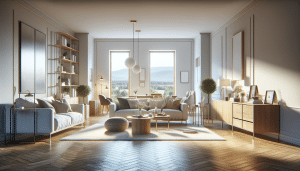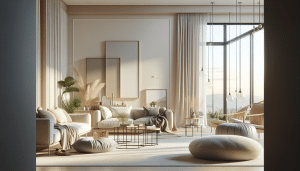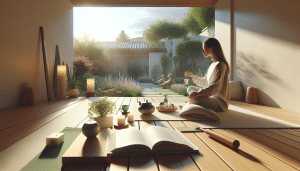You Deserve a Home Sanctuary Makeover
Jessica White September 15, 2025
Transforming a living space into a personal sanctuary is a growing trend in lifestyle and entertainment. This guide explores how to create a calming home environment through design choices, wellness routines, peaceful decor, technology, and sustainable materials—all woven together for comfort and rejuvenation.
Crafting a Calming Space with Mindful Design
Home is more than just a place to rest. For many, it’s a sanctuary where comfort and peace are essential. To create such an environment, mindful interior design is an effective approach. Incorporating elements like natural light, soft textures, and decluttered layouts brings a sense of ease. Positioning furniture to improve flow and using colors that encourage relaxation, such as soft earth tones or muted blues, can set the tone for serenity. Design experts recommend selecting items intentionally, reducing visual noise, and allowing open space, which research suggests can help to lower stress and boost feelings of wellbeing (https://www.ncbi.nlm.nih.gov/pmc/articles/PMC7605299/).
Sound plays a major role in shaping the home experience. Many people have found that introducing elements like water features, soft instrumental music, or sound-absorbing materials further enhances tranquility. Acoustic panels, plush carpeting, and heavy drapes can be used to reduce echoes and noise pollution. By blending in these auditory cues, the home’s energy subtly shifts—making daily routines gentler. This multi-sensory approach to relaxation in the living space is becoming a foundation in modern lifestyle design habits.
Minimalism also has an unmistakable influence on sanctuary-inspired design. While some opt for a pure minimalist look, others blend it with botanical touches—plants, wood, and stone. Integrating nature indoors through decor or biophilic design connects individuals to the calming patterns of the natural world. This union of simplicity and organic materials reflects priorities seen in wellness-based entertainment and lifestyle circles, helping the home become not just stylish but restorative.
Creating a Daily Wellness Ritual at Home
Turning routine into ritual is at the core of personal sanctuary living. Wellness routines, from meditation to herbal tea breaks, contribute to a peaceful daily rhythm. Studies have shown that setting aside moments for mindfulness or gratitude journaling helps individuals manage stress. Carving out even five minutes in a favorite chair or a sunlight-filled corner allows the mind to reset. Adding small comforts such as aromatherapy, soft throws, or curated reading lists enhances these rituals, making them something to look forward to rather than a checkbox on a to-do list (https://www.ncbi.nlm.nih.gov/pmc/articles/PMC5814950/).
For some, wellness means movement. Gentle activities like restorative yoga or stretching sequences can be woven directly into the home setting. Curating a specific area with space for a yoga mat or simple equipment turns wellness from an afterthought into a highlight of daily life. Lighting scented candles or playing nature sounds as part of the routine magnifies the soothing effect, offering entertainment that rejuvenates body and mind alike.
Nutrition has a rightful place in any wellness sanctuary. Preparing wholesome snacks or herbal infusions, and setting a dedicated spot for mindful eating, aligns mealtime with restorative values. Many choose to display fresh herbs, fruits, or even small indoor gardens, reinforcing the connection between nourishment, beauty, and lifestyle—a theme celebrated in contemporary home living and entertainment platforms.
Choosing Decor That Inspires Peace
Decor plays a profound role in creating a sanctuary-like atmosphere at home. A popular emerging approach involves picking decor that’s both meaningful and peaceful, contributing to the overall sense of wellbeing. Items with personal stories—think travel mementos, handcrafted pottery, or framed nature photography—bring comforting energy. Such pieces draw the eye and heart, turning everyday surroundings into a tapestry of positive reminders. For those seeking inspiration, following curated entertainment content or exploring online design showcases can spark new ideas and help discover your unique style (https://www.ncbi.nlm.nih.gov/pmc/articles/PMC7144731/).
Plants are top choices in sanctuary decor. Their ability to purify indoor air and increase access to natural beauty is well documented. From lush potted greenery to hanging terrariums, plants add layers of interest and calm to interiors. Many find tending to plants a soothing hobby, one that connects nature and nurture. Online communities often share tips for beginners, making plant care an entertaining learning experience that complements home aesthetics and wellness goals.
Layered lighting is another essential. Instead of relying solely on harsh overhead lights, incorporate soft floor lamps, wall sconces, or string lights to create cozy, inviting atmospheres. Dimmers allow easy adjustment depending on mood or time of day, supporting evening wind-downs or energizing early routines. Thoughtful lighting instantly transforms a space, making it more adaptable and supportive of restful living. These decor strategies work harmoniously for anyone looking to turn home life into a delightful, entertaining retreat.
Integrating Smart Home Tech for Ease
Today, home sanctuaries increasingly benefit from technology designed to promote comfort and convenience. Smart devices, such as programmable lights or speakers, can automatically adjust ambiance for relaxation or entertainment with just a voice command. These devices let users create customizable routines—such as turning on calming music at sunset or warming bedroom lights at sunrise. Innovative tech brings efficiency, but when used thoughtfully, it can also foster a sense of ease and control within the home setting (https://www.epa.gov/indoor-air-quality-iaq/improving-indoor-air-quality).
Entertainment options expand home sanctuary possibilities. Streaming platforms offer endless choices for music and video, from guided meditations to slow-TV screen savers that bring soothing landscapes into the living room. Smart thermostats, air purifiers, and even circadian rhythm lighting synchronize home conditions with your preferred wellness settings. Integrating these tools can help maintain steady comfort, offer variety, and keep healthy routines on track without demanding attention or creating additional stress.
Privacy and downtime are just as vital. Tech-free zones, such as a reading nook or a window seat, encourage regular breaks from screens. Setting boundaries for device use can increase presence during activities and deepen relaxation. When managed with intention, home technology becomes a supportive rather than distracting force, aligning with broader goals for balanced, enjoyable living and entertainment.
Embracing Sustainable Choices in Your Sanctuary
Sustainability has become a leading theme for many aiming to make their homes sanctuaries of wellbeing. Incorporating eco-friendly materials and energy-efficient devices doesn’t just benefit the planet—it also enhances indoor air quality and reduces exposure to toxins. Features like organic cotton linens, recycled glass accents, or bamboo flooring serve both beauty and responsibility. Choosing sustainable brands or secondhand furniture adds character, aligning home aesthetics with values of conscious living (https://www.niehs.nih.gov/health/topics/agents/indoor-air/index.cfm).
Zero-waste practices are entering home life as well. Refillable cleaning products, compost bins, and eco-friendly storage solutions help reduce clutter and environmental impact. Simple shifts, such as using cloth napkins or beeswax wraps, are easy to adopt and often spark creative DIY projects. Households experimenting with sustainability find gratification in these routines, and such habits are frequently shared on lifestyle platforms and entertainment vlogs, inspiring communities to try gentle green changes.
Conscious consumption encourages buying less but choosing better. This approach prioritizes long-lasting products that are both practical and beautiful. Community swaps, ethical shopping guides, and mindful decluttering tips all support a sustainable, sanctuary-inspired home. These choices, big and small, foster a sense of pride and tranquility—deepening the connection to the space and echoing the larger entertainment and lifestyle conversations around eco-friendly living.
Personalizing Your Space for Lasting Comfort
Personal touches make any living space a true sanctuary. Whether it’s displaying favorite books, proudly hanging family photos, or arranging a cozy reading chair, each detail contributes to comfort and identity. Design psychology highlights the power of personalization in boosting happiness and belonging. Even the smallest adjustments—a signature scent, a colorful throw pillow, or an art wall—can refresh the mood and increase positive associations with home (https://www.va.gov/WHOLEHEALTHLIBRARY/tools/creating-healing-environment.asp).
Shared spaces deserve attention, too. Collaborating with family or roommates to choose communal decor themes, music playlists, or wellness routines helps ensure everyone feels included. This joint investment in the home’s atmosphere supports stronger social bonds. Enjoyable group activities, such as movie nights or meal prep, can become beloved rituals—adding layers of enjoyment and new entertainment possibilities within the home.
Above all, personalization means adapting to changing needs. Spaces evolve with time, just as interests and routines do. Periodically reviewing decor, layout, or wellness practices keeps the sanctuary feeling fresh. There’s freedom to explore, experiment, and find ongoing joy in shaping—the ultimate entertainment is found in creating a home that truly feels like one’s own retreat.
References
1. Li, D., Sullivan, W. C., & Wu, C. (2020). Nature, stress reduction, and mental health in urban environments. Retrieved from https://www.ncbi.nlm.nih.gov/pmc/articles/PMC7605299/
2. Goyal, M., Singh, S., Sibinga, E. M. S., et al. (2014). Meditation programs for psychological stress and well-being: A systematic review and meta-analysis. Retrieved from https://www.ncbi.nlm.nih.gov/pmc/articles/PMC5814950/
3. Soga, M., Gaston, K. J., & Yamaura, Y. (2017). Gardening is beneficial for health: A meta-analysis. Retrieved from https://www.ncbi.nlm.nih.gov/pmc/articles/PMC7144731/
4. U.S. Environmental Protection Agency. (n.d.). Improving indoor air quality. Retrieved from https://www.epa.gov/indoor-air-quality-iaq/improving-indoor-air-quality
5. National Institute of Environmental Health Sciences. (n.d.). Indoor air quality. Retrieved from https://www.niehs.nih.gov/health/topics/agents/indoor-air/index.cfm
6. U.S. Department of Veterans Affairs. (n.d.). Creating a healing environment. Retrieved from https://www.va.gov/WHOLEHEALTHLIBRARY/tools/creating-healing-environment.asp








